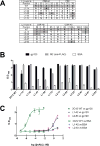Interrogation of side chain biases for oligomannose recognition by antibody 2G12 via structure-guided phage display libraries
- PMID: 28947103
- PMCID: PMC5632219
- DOI: 10.1016/j.bmc.2017.09.013
Interrogation of side chain biases for oligomannose recognition by antibody 2G12 via structure-guided phage display libraries
Abstract
Monoclonal antibodies (mAbs) are essential reagents for deciphering gene or protein function and have been a fruitful source of therapeutic and diagnostic agents. However, developing anticarbohydrate antibodies to target glycans for those purposes has been less successful because the molecular basis for glycan-mAb interactions is poorly understood relative to protein- or peptide-binding mAbs. Here, we report our investigation on glycan-mAb interactions by using the unique architectural scaffold of 2G12, an antibody that targets oligomannoses on the HIV-1 glycoprotein gp120, as the template for engineering highly specific mAbs to target glycans. We first analyzed 24 different X-ray structures of antiglycan mAbs from the Protein Data Bank to determine side chain amino acid distributions in of glycan-mAb interactions. We identified Tyr, Arg, Asn, Ser, Asp, and His as the six most prevalent residues in the glycan-mAb contacts. We then utilized this information to construct two phage display libraries ("Lib1" and "Lib2") in which positions on the heavy chain variable domains of 2G12 were allowed to vary in restricted manner among Tyr, Asp, Ser, His, Asn, Thr, Ala and Pro to interrogate the minimal physicochemical requirements for oligomannose recognition. We analyzed the sequences of 39 variants from Lib1 and 14 variants from Lib2 following selection against gp120, the results showed that there is a high degree of malleability within the 2G12 for glycan recognitions. We further characterized five unique phage clones from both libraries that exhibited a gp120-specific binding profile. Expression of two of these variants as soluble mAbs indicated that, while specificity of gp120-binding was retained, the affinity of these mutants was significantly reduced relative to WT 2G12. Nonetheless, the results indicate these is some malleability in the identity of contact residues and provide a novel insight into the nature of glycan-antibody interactions and how they may differ from protein-antibody binding interactions.
Copyright © 2017 Elsevier Ltd. All rights reserved.
Figures





Similar articles
-
A strategy for phage display selection of functional domain-exchanged immunoglobulin scaffolds with high affinity for glycan targets.J Immunol Methods. 2012 Feb 28;376(1-2):150-5. doi: 10.1016/j.jim.2011.12.008. Epub 2011 Dec 31. J Immunol Methods. 2012. PMID: 22233878 Free PMC article.
-
STD NMR study of the interactions between antibody 2G12 and synthetic oligomannosides that mimic selected branches of gp120 glycans.Chembiochem. 2012 Jun 18;13(9):1357-65. doi: 10.1002/cbic.201200119. Epub 2012 May 24. Chembiochem. 2012. PMID: 22628288
-
A peptide inhibitor of HIV-1 neutralizing antibody 2G12 is not a structural mimic of the natural carbohydrate epitope on gp120.FASEB J. 2008 May;22(5):1380-92. doi: 10.1096/fj.07-8983com. Epub 2008 Jan 15. FASEB J. 2008. PMID: 18198210 Free PMC article.
-
Evolution of phage display libraries for therapeutic antibody discovery.MAbs. 2023 Jan-Dec;15(1):2213793. doi: 10.1080/19420862.2023.2213793. MAbs. 2023. PMID: 37222232 Free PMC article. Review.
-
Anti-glycan monoclonal antibodies: Basic research and clinical applications.Curr Opin Chem Biol. 2023 Jun;74:102281. doi: 10.1016/j.cbpa.2023.102281. Epub 2023 Mar 9. Curr Opin Chem Biol. 2023. PMID: 36905763 Free PMC article. Review.
Cited by
-
Monoclonal antibodies from humans with Mycobacterium tuberculosis exposure or latent infection recognize distinct arabinomannan epitopes.Commun Biol. 2021 Oct 12;4(1):1181. doi: 10.1038/s42003-021-02714-w. Commun Biol. 2021. PMID: 34642445 Free PMC article.
-
Strategies and Tactics for the Development of Selective Glycan-Binding Proteins.ACS Chem Biol. 2021 Oct 15;16(10):1795-1813. doi: 10.1021/acschembio.0c00880. Epub 2021 Jan 26. ACS Chem Biol. 2021. PMID: 33497192 Free PMC article. Review.
References
-
- Bertozzi CR, Kiessling LL. Chemical glycobiology. Science (New York, N.Y.) 2001;291(5512):2357–64. - PubMed
-
- Prescher JA, Bertozzi CR. Chemical technologies for probing glycans. Cell. 2006;126(5):851–4. - PubMed
-
- Lee HY, Chen CY, Tsai TI, Li ST, Lin KH, Cheng YY, Ren CT, Cheng TJ, Wu CY, Wong CH. Immunogenicity study of Globo H analogues with modification at the reducing or nonreducing end of the tumor antigen. Journal of the American Chemical Society. 2014;136(48):16844–53. - PubMed
-
- Collins BE, Paulson JC. Cell surface biology mediated by low affinity multivalent protein-glycan interactions. Current opinion in chemical biology. 2004;8(6):617–25. - PubMed
-
- Blixt O, Collins BE, van den Nieuwenhof IM, Crocker PR, Paulson JC. Sialoside specificity of the siglec family assessed using novel multivalent probes: identification of potent inhibitors of myelin-associated glycoprotein. The Journal of biological chemistry. 2003;278(33):31007–19. - PubMed
MeSH terms
Substances
Grants and funding
LinkOut - more resources
Full Text Sources
Other Literature Sources

